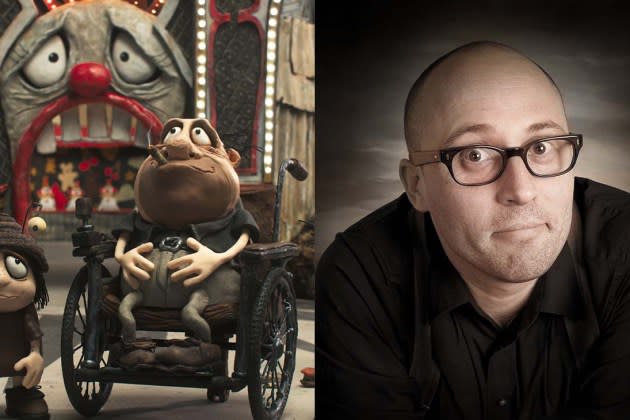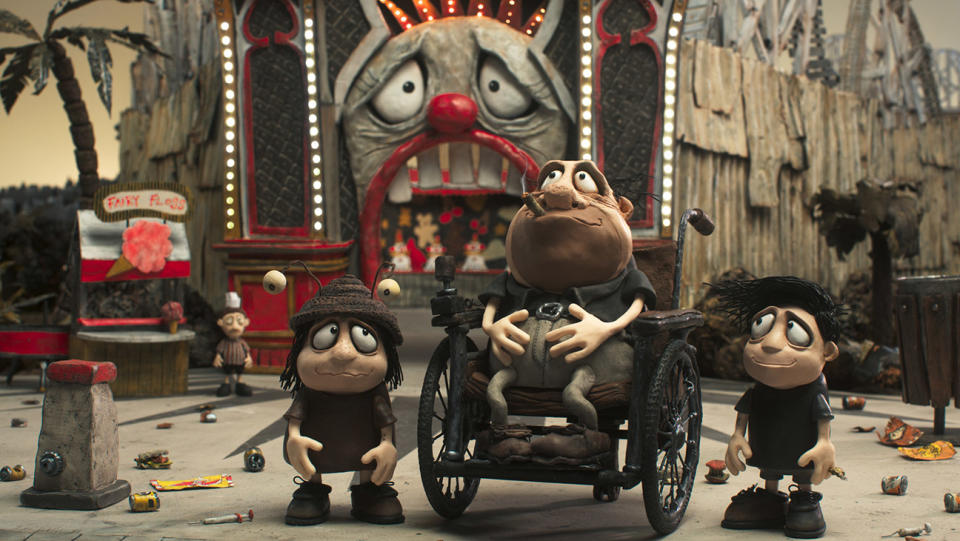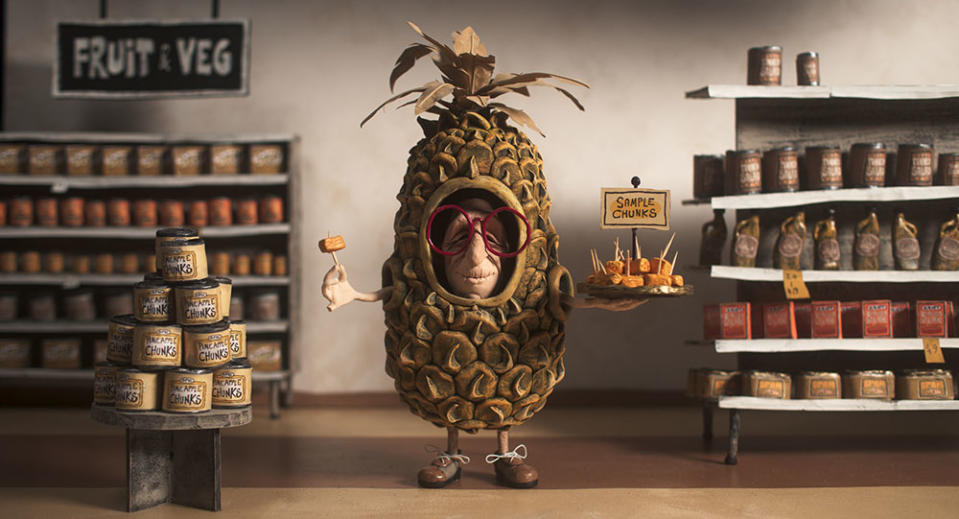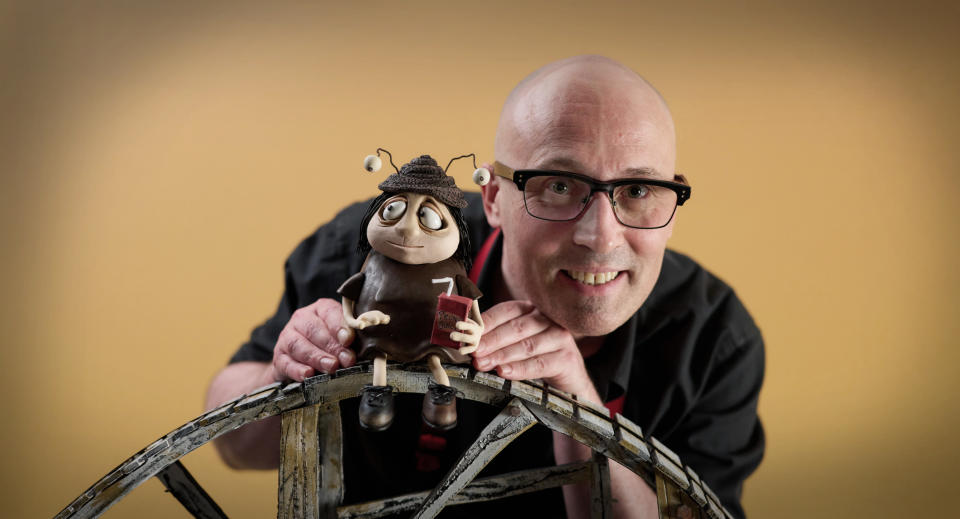Adam Elliot Talks ‘Memoir of a Snail,’ Claymation as “A Form of Therapy”

You could call Adam Elliot the Australian Nick Park. But while the British Wallace and Gromit creator and his Aardman studio have gone from award-winning claymation shorts to big-budget animation features made with the likes of Dreamworks (Chicken Run, Flushed Away) and Netflix (Chicken Run: The Dawn of the Nugget, the upcoming Wallace and Gromit movie), back in Melbourne, Elliot has kept things small.
His entire filmography: The three shorts Uncle (1996), Cousin (1999), and Brother (2000), two mid-length films Harvie Krumpet (2003) and Ernie Biscuit (2015) and his two features: Mary and Max in 2009 and Memoir of a Snail, together clock in at around 4 hours. You can become an Elliot completist in a single afternoon binge.
More from The Hollywood Reporter
Mia-McKenna Bruce, Martin Freeman, Helena Bonham Carter Set for Netflix Agatha Christie Show
'Twin Peaks' Episode, David Lynch Short, Restored Wim Wenders Film Join Karlovy Vary Fest Lineup
Three decades into his career, with an Oscar to his name (best animated short for Harvie Krumpet in 2004), Elliot continues to tell the same sort of stories: Semi-autobiographical dark and funny tales of outsiders, mostly living in 1970s Australia, using the same handcrafted stopmotion techniques. No digital animation required.
His latest, Memoir of a Snail, is very much an Adam Elliot film. Set, of course, in Australia in the 1970s, it stars Succession‘s Sarah Snook as Grace Pudel. A shy girl born with a cleft palate, Grace grows up with her wild and occasionally pyromaniac twin brother Gilbert (Kodi Smit-McPhee) but, scared by sadness and death, she eventually becomes a lonely hoarder of ornamental snails, her only friend a wild octogenarian named Pinky (Jacki Weaver). Eric Bana, Dominique Pinon, and Nick Cave provide supporting voice work.
Ahead of Memoir of a Snail‘s world premiere at this year’s Annecy animation festival, Adam Elliot spoke about “balancing the light and the dark” in his movies, claymation as a “form of therapy,” and why instead of going Hollywood he plans to “stay here in little Melbourne and keep telling my little stories.”
Animation famously takes a long time and stop-motion even longer. What was the starting point for this film and what was it about the idea that made you want to spend so many years of your life in this story?
This really began when my father died. He was a bit of a hoarder. And my mother, who’s still alive, she’s a bit of a reformed hoarder. I became fascinated by why they had collected all this stuff. When does a collection become a hoard? And when does it become a problem? That was the trigger. I have a very close friend who was born with a very severe cleft palate and has had many operations over her life. And she’s now such an extrovert and in many ways, the complete opposite of what she was as a child. And so those two ideas came together very quickly.
And there’s a lot of myself in Grace as well. My films are always based on my family and friends but I can’t help but to put a lot of myself in the characters as well. The script went through a lot of transformations. I think ultimately, it became the story of a woman who was trapped in her own shell. The theme of cages became quite present. I was a bit worried about that at first because, you know, cages have been a theme in so many films and stories.

Why did you pick snails as the object of obsession, and the stand-in animal metaphor for Grace?
I knew it was always going to be an animal or an insect. Originally the film was about a woman who collected ladybirds and ladybugs. But ladybirds just became a bit cutesy and I thought: ‘What animal really is more symbolic of Grace?’ As a child, I collected a lot of snails in ice cream containers, and, like most kids, I’d touch their antennas and they’d recoil as they do. I thought, actually that is great. Grace is also recoiling into herself a lot. So snails just seemed the logical choice. Then there’s the motif of the swirl, you know, it’s a timeless symbol of life evolving and going full circle. A lot of that symbolism came in later. But there’s also just something funny about snails. I think a snail is just funnier than an ant or a worm. There’s something about snails that make them endearing and likeable.
But, you know, there are times I wished I’d written a film about a minimalist and not a hoarder. Because the reality is, we had to make 1000s and 1000s of these little ornaments. Which was quite a challenge.
What will happen to that hoard of mini snails now?
We have this wonderful museum here in Melbourne called the Australian Centre for the Moving Image. And like my previous film, Mary and Max, they’re going to exhibit all the bits and pieces, the 1000s of props and sets and characters. The reality is they have started to fall apart. The eyeballs are falling out and fingers are dropping off. They’re in pretty bad shape. But the public really loves seeing them, warts and all. A lot of people think they’re very little too but they’re actually quite big. But, like most of my films, most of the assets end up in the rubbish dump.
How long did it take from the idea to the finished film?
Memoir of a Snail was eight years from script to screen, If you took COVID out of the equation, it would have been much quicker. But I think with stop motion and animation in general, it’s always more about what you leave out than what you put in. It’s a very prescribed form, you have to learn to be succinct. I always say that writing screenplays is a process of distillation. It’s getting the film down to its bare minimum. That’s why I do so many drafts: Because I really don’t know what it is I’m trying to say until maybe the 10th draft. I write back to front, I start off with the detail and hope by the sixth draft that there’s some sort of three-act structure magically appearing.
I keep a diary for every production. And in my diary, we went up to number 594. So that’s the first day of pre-production. The shoot was 32 weeks, with six months of preproduction, and seven months of post. But the writing was probably over a three-year period. And then, of course, COVID hit and slowed things down in the financing. It should have really been five years, not eight years. But I don’t know if that’s so long, because the average film globally, live action and animation, takes, on average, around seven years to get made.
You continue to do handmade movies, with traditional stop-motion and claymation, and no digital techniques or animation, which must add to the work.
Well, I think in a way my films are a form of therapy. The process of making them is very meditative. Some people see stop motion as being excruciating and tedious, but I find it very relaxing. I learned a lot about myself through the process. It is a very expensive, slow art form. But I never quite know where the films are going to end up. There’s a lot of spontaneity in what I do. The animation is often so planned out but I try and allow for spontaneity. Even when we’re animating, I say to the animators: ‘Look, if something negative happens, if the character’s ear drops off or a finger breaks, keep going and see if you can incorporate that into the movement.’ Other animators would abandon it and start again but I love serendipitous moments and happy accidents. There are plenty of shots in the film which weren’t how I imagined them. But in some cases, they turned out funnier or more poignant than how I had planned.
If you compare this production to that of one of your fellow Australian directors, George Miller on Mad Max: Fury Road, which took 20 years to make, 8 year doesn’t look so bad. You have your own Mad Max-esque scene in the film, your first-ever action scene, where Gilbert runs out into a busy street to save a snail.
Over the years, I’ve avoided action scenes. They’re very tricky to do in stop motion. But I knew I had to do one eventually. So I thought: ‘What about an action scene with a snail trying to be rescued?’ Luckily, I have a wonderful cinematographer [Gerald Thompson] and animation supervisor [John Lewis]. I mean, the truth is, I’m a terrible animator. I’ve never been terribly good at it or even liked it much. I’d much prefer my animators do all the work for me. I love storyboarding, though. So I do all my own storyboards. I still draw on paper and I do all the production design. Over the years, I’ve been able to pick and choose which of the stages I want to pull back from.
But I think in many ways, the most challenging part of this film was really in the edit. This was the hardest film I’ve ever had to edit. And I’ve used the same editor for three films now: Bill Murphy, who’s almost retired now and he’s got a really good sense of timing. In this film it was really challenging to get that balance between the comedy and the tragedy. There is a lot of death in this film, there’s a lot of challenging subject matter: Attempted suicide, depression and all the rest. Just trying to get that light and shade, to get that rhythm, was tough. We did a lot of cuts, but I think we got there in the end.

As with Mary and Max you have another all-star voice cast, led by Sarah Snook as Grace, Kodi Smit-McPhee as Gilbert, and the incomparable Jacki Weaver as Grace’s senior citizen buddy Pinky. Did you have them in mind from the start?
I had Sarah Snook in mind quite early. In Australia, we’re limited by female actors who have international profiles. There’s obviously Cate Blanchett, Nicole Kidman, and Margot Robbie. And we certainly thought about all those actors. But Sarah was the only actor that really seemed to fit. I didn’t want her to act in it as much as I wanted her natural speaking voice. She’s an incredible actor, of course, and in many ways, she directed me. She brought so much more to Grace than I had been hoping for.
Jacki was the natural choice for Pinky, because she’s just such a funny person in real life. And she’s age-appropriate. But I certainly don’t obsess about which actors I want to have. I know the investors always want big international names, but sometimes you can get it wrong too. Sometimes you have a big name and you might have a beautifully acted character, but the voice and the animation don’t marry up. I know with Paddington, they had a lot of trouble because they first had Colin Firth doing the voice of Paddington and it just didn’t work, so they got Ben Whishaw to come in and replace him. I love an eclectic cast and I love having non-actors or celebrities who come in to do cameo roles.
But with the leads, I often have one person in mind. I remember with Mary and Max, Max had to be Philip Seymour Hoffman. And for this film, Sarah just seemed to be the person we really wanted. Luckily, the timing was right. She’s just come off Succession and she lives here in Melbourne, so that was handy.
It’s a quite different role for her, particular from her character in Succession. As a shy, withdrawn snail hoarder.
Yeah, but Sarah’s actually quite a homebody in real life. She’d turn up to the recording just in her leisure wear, driving herself. She’s very unpretentious. Doesn’t like the fame and the glitz and the glamour around her. She’s very, down to earth, and very self-deprecating. I was very glad when she said she could relate to Grace and identified with her. We did about six sessions with her over six months and she’s probably the easiest actor I’ve ever had to work with.
Like Mary and Max, Memoir of a Snail is set in Australia in the 1970s. Is the film a look back at your own childhood, and do you view that period nostalgically, because there’s a lot of darkness in this film as well.
Yes certainly. I love the 70s and I love 70s films. And so there’s a little bit of nostalgia in there. But I think too, as children, we were much more free in the 70s. We were able to do what we wanted. Gilbert in many ways is a lot like myself. He was a free spirit who, in many ways, is encouraged to take risks, almost encouraged to be a pyromaniac.
The aesthetic palate of the films is very brown, which I remember the 70s as being. Everyone in Australia painted their houses mission brown and painted the walls cream. It was a very beige era.
From my 70s childhood in Canada, I also remember a lot of orange…
Yes, burnt orange! The burnt orange shag pile carpet was very big here in Australia too. But ultimately, I’m trying to get a balance between the comedy and the tragedy, the light in the dark. I love that quote that without the dark, the light has no meaning.
My films are based on my family and friends and I think everybody’s lives have light and shade. My characters certainly have a lot of bad luck. But I want the audience by the end of the film to empathize with the characters, to relate to them. I don’t like my characters becoming too refined aesthetically, I like imperfection and asymmetry. I love the underdog. I’ve always told stories about people who are marginalized and misunderstood and on the fringes, I’m not really interested in heroes, although, you know, my characters can be heroic at times, but they are certainly perceived as different.

With Mary and Max, my last film, I really started to become obsessed with imperfection, with how we’re all fundamentally flawed in some way, and that a lot of us hide our flaws but that we have to learn to embrace our flaws. Of course, these are subject matters that have been explored a lot in cinema, but with Grace, what I found interesting is that she really doesn’t transform a lot. She has a lot of bad luck and a lot of trauma and she grows a little bit, but ultimately, she very inactive. She doesn’t really become proactive until right at the last moment.
I think too, with animation, you can get away with a lot more. I don’t think my films would work as live-action films. And because my films are more niche, I have a lot more creative freedom and control and I can really get away with a lot more than I would with a big, mainstream big-budget, animated film. But there are just the sort of stories I’m attracted to.
Your 2003 short film Harvie Krumpet won an Oscar, Mary and Max was a critical hit and went around the world. You must have gotten offers to do big-budget movies.
Oh, sure. I’ve had a lot of offers to direct other people’s films, for 2D animation, stop motion, bigger budget movies. It’s always tempting. But, to my own detriment, my own detriment financially, I’ve always said no. I’ve always had an idea in the back of my head that I’ll tell the stories I want to tell how I want to tell them. I’m very lucky here in Australia to have government financing systems supporting me, so I’ve been able to make back-to-back films. Look, it’s very tempting, but I think the purist in me doesn’t want to sell out. And also to my crew, the people I work with, don’t want me to abandon ship. They want me to stay here in little Melbourne and keep telling my little stories.
I’ve never starved, but there are some days I think: ‘If only I’d done that Smurfs film’ or taken that big offer.’ But no, I think I’m happy now with what I’ve done and where I’m heading.
The lesson I’ve learned, however, particularly with Mary and Max, is that my films tend to have longevity. I still get emails every week about Mary and Max from people who’ve seen the film for the first time and it feels very fresh to them. Now that I’m in my 50s, I’m thinking more about these pretentious ideals, like legacy, and what am I going to leave behind. All that sort of stuff.
Do you know what you want to do next, now that Memoir of a Snail is done and premiering in Annecy?
I always have something in the back of my head. When I was at film school, I had this pretentious idea of doing a trilogy of trilogies: Three shorts, three long shorts and three features. And it’s sort of come true. I’ve only got one short and one feature left to go and then I’ll have my trilogy of trilogies.
Now, I do love narration in a film and I think the next film will have voiceover too. But this film is my first film that’s been a memoir. Mary and Max was a voiceover by two actors. My shorts all have anonymous narrators. But the next one I think is gonna be more diary entries. I’ve also always wanted to do a road movie. But I want to do a road film about an elderly woman who goes on a road trip. That’s all I know at this stage.
But expect more of the same. I worry sometimes that I’m becoming formulaic. But I learned the lesson years ago that you’ve got to keep pushing the boundaries of your art form. If you don’t, it becomes stale, and when it becomes stale, it dies. So I really want to push myself with this next one.
Best of The Hollywood Reporter

 Yahoo News
Yahoo News 
